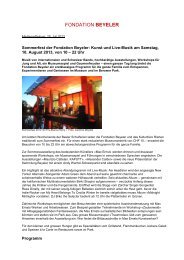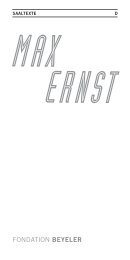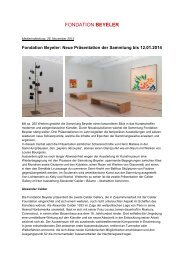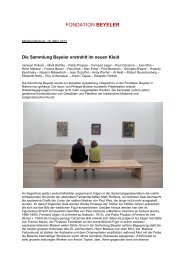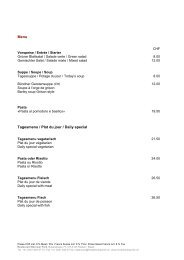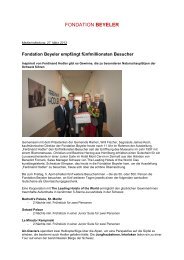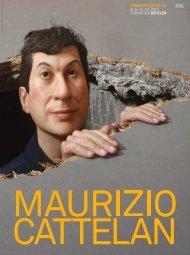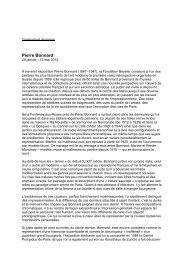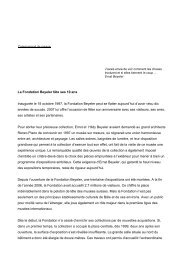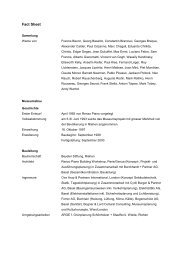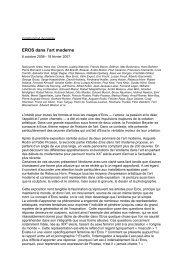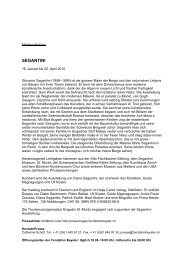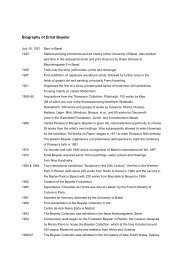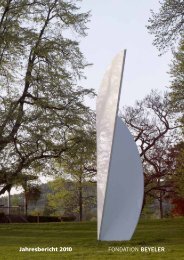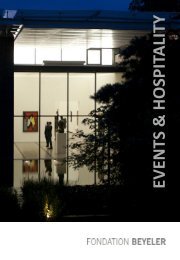Jeff Koons - Fondation Beyeler
Jeff Koons - Fondation Beyeler
Jeff Koons - Fondation Beyeler
You also want an ePaper? Increase the reach of your titles
YUMPU automatically turns print PDFs into web optimized ePapers that Google loves.
Press Release<br />
<strong>Jeff</strong> <strong>Koons</strong><br />
13 May – 2 September 2012<br />
The <strong>Fondation</strong> <strong>Beyeler</strong> is presenting the first exhibition ever devoted by a Swiss museum to<br />
the American artist <strong>Jeff</strong> <strong>Koons</strong> (b. 1955). <strong>Koons</strong>, likely the best-known living artist, has for<br />
decades been causing a furore with the combination of popular and high culture that informs<br />
his art.<br />
Our extensive presentation focuses on three central series of works – The New, Banality and<br />
Celebration – which represent crucial stages in <strong>Koons</strong>’s development and lead to the nucleus<br />
of his thinking and creative activity. The New comprises the ready-made-like cleaning applicances<br />
of his early period, symbols of newness and purity. Banality includes those traditionnally<br />
crafted sculptures in porcelain and wood which have since become (post-) modern<br />
icons. Finally, in the Celebration series, on which <strong>Koons</strong> has been working for almost twenty<br />
years, appear high-gloss steel sculptures of unique material perfection, and large-format<br />
paintings in which the artist celebrates childhood in a veritably baroque way.<br />
<strong>Koons</strong>’s equally spectacular and subtle works are repeatedly concerned with themes such as<br />
innocence, beauty, sexuality and happiness. These reflect his conception of an art that is<br />
accessible to every viewer.<br />
In parallel with the exhibition, <strong>Jeff</strong> <strong>Koons</strong>’s monumental floral sculpture Split-Rocker,<br />
composed of thousands and thousands of real plants and introducing a unique dialogue<br />
between art and nature, will be installed in the <strong>Fondation</strong> <strong>Beyeler</strong> park.<br />
The exhibition is curated by Sam Keller, Director, and Theodora Vischer, Senior Curator at<br />
Large, at the <strong>Fondation</strong> <strong>Beyeler</strong>.<br />
The following lenders have contributed materially to the success of the exhibition: <strong>Jeff</strong> <strong>Koons</strong>;<br />
The Brant Foundation, Greenwich, Connecticut; The Broad Art Foundation, Santa Monica;<br />
Des Moines Art Center; Kunstmuseum Wolfsburg; The Rachel and Jean-Pierre Lehmann<br />
Collection; Prada Collection, Milan; Rubell Family Collection, Miami; The Sonnabend<br />
Collection; Tate / National Galleries of Scotland; Whitney Museum of American Art, New<br />
York.<br />
The catalogue, in German and English, is published by Hatje Cantz Verlag, Ostfildern. It<br />
contains a foreword by Sam Keller and Theodora Vischer, an interview with the artist, and<br />
essays by Raphaël Bouvier and Günther Vogt. 212 pages, 154 illustrations, CHF 68. ISBN<br />
978-3-906053-00-4 (German), ISBN 9878-3-906053-01-1 (English).<br />
The exhibition enjoys the generous support of Mercedes Benz and Hugo Boss.<br />
The outdoor sculpture Split Rocker was made possible by a substantial contribution from JTI<br />
as principal partner, as well as the support of Simone and Peter Forcart-Staehelin and<br />
InCentive Asset Management AG.
Press images available at: http://pressimages.fondationbeyeler.ch<br />
Further information:<br />
Andrea Tedeschi, Head of Public Relations<br />
Tel. + 41 (0)61 645 97 21, presse@fondationbeyeler.ch, www.fondationbeyeler.ch<br />
<strong>Fondation</strong> <strong>Beyeler</strong>, <strong>Beyeler</strong> Museum AG, Baselstrasse 77, CH-4125 Riehen, Switzerland<br />
<strong>Fondation</strong> <strong>Beyeler</strong> opening hours: 10.00 am to 6.00 pm, Wednesdays to 8.00 pm
Press Release<br />
<strong>Jeff</strong> <strong>Koons</strong><br />
13 May – 2 September 2012<br />
<strong>Jeff</strong> <strong>Koons</strong> (b. 1955) is one of the best known contemporary artists, whose work has repeatedly<br />
caused a furore since the 1980s. He has been especially renowned for works that call the conventional<br />
distinction between art and kitsch into question. The <strong>Fondation</strong> <strong>Beyeler</strong> is presenting the first<br />
<strong>Koons</strong> exhibition ever held in a Swiss museum.<br />
From the start <strong>Koons</strong> worked in terms of chronological series of pieces, each with its own title.<br />
Taken together, these series titles provide an overview of his artistic conception. Our extensive<br />
show comprises about 50 works from three central groupings that represent crucial steps in<br />
<strong>Koons</strong>'s development and pursue the unusual path, combining popular and high culture, which the<br />
object has taken and is still taking in his oeuvre.<br />
The three series selected together with the artist for exhibition are The New (1980-87), Banality<br />
(1988) and Celebration (from 1994).<br />
The exhibition spans a wide arc from The New, the young artist's early series, to Celebration, to<br />
which new pieces are still being added today. In between we find Banality, an influential grouping<br />
with a manifesto-like character and crucial for <strong>Koons</strong>'s self-definition as an artist. Taken together,<br />
these three series reflect the core of <strong>Koons</strong>'s thinking and the internal cohesion of the entire<br />
oeuvre, something that tends to be obscured by the system of groups of works with their separate<br />
titles.<br />
In The New, which would become determinant for the artist's development, he purposely focused<br />
on factory-new, unused vacuum cleaners and carpet cleaning appliances of the Hoover brand,<br />
which, placed over flourescent tubes, are encased in plexiglass cases. In this way, the objects<br />
create an impression of cleanliness and seductive value, embodying the ideal of newness. Basic<br />
themes of this series are integrity, innocence and purity -- values that run through <strong>Koons</strong>'s oeuvre<br />
as a whole. In terms of their stringent arrangement and placement on fluorescent lights, these<br />
objects recall Minimal Art.<br />
Yet <strong>Koons</strong> is also one of the artists who have taken up the discussion on objects launched by<br />
Duchamp at the start of the twentieth century with his ready-mades. He has advanced this discussion<br />
in an original and masterfully brilliant way.<br />
From The New series, the exhibition presents thirteen works, including a display window installation,<br />
reconstructed with the original vacuum cleaners, that was on view in 1980 at The New<br />
Museum of Contemporary Art in New York. In this series, the celebration of newness finds<br />
expression not only in the vacuum cleaner works but in the programmatic The New <strong>Jeff</strong> <strong>Koons</strong><br />
(1980), comprising a lighted box with a black and white photo of the artist as a boy. The young<br />
<strong>Koons</strong>'s self-confidence had already become evident by this time.<br />
The advertising posters <strong>Koons</strong> employed for his silkscreen prints reflect his special interest in<br />
commercial imagery and visual strategies. In combination with the showcase objects, they<br />
immediately confront the viewer with the basic message of the series and the artist's fascination<br />
with the manipulative potential of images and their presentation, as well as his intention to make
the work of art as accessible to the viewer as possible. As an image on canvas, the lithograph<br />
New! New Too! (1983) is an early indicator of <strong>Koons</strong>'s concern with monumental painting, which<br />
would come to fruition years later, in the Celebration series.<br />
The ready-made-like everyday objects in The New metamorphosed in Banality into strange and<br />
provocative sculptures in wood, porcelain and mirrored glass, made by traditional crafts methods.<br />
Their motifs were taken equally from art history and popular culture, and collaged into innovative<br />
figures with a Baroque-oriented aesthetic. With the much-acclaimed Banality series, the artist not<br />
only placed the definition of art on a new foundation but advanced to become a star of the<br />
international art scene.<br />
The exhibition includes sixteen sculptures and reliefs, a major portion of the series of twenty sculptural<br />
figures. The motifs in Banality stem from a wide range of imagery from Renaissance and<br />
Baroque art, popular magazines, and the world of toys and postcards.The initial motif is modified<br />
such that the figures run through a transformation in terms of change of scale, medium or material<br />
which lends them new potentials of interpretation.<br />
The guiding idea behind Banality is the self-acceptance of the viewer conveyed by ostensibly banal<br />
things. This idea is embodied in the polychrome, quasi-religious wood sculpture Ushering in<br />
Banality (1988), which as it were manifests the banal as <strong>Koons</strong>'s fundamental ideal.<br />
A further theme of the Banality series is the association between human and animal that characterizes<br />
many of the works, for instance Stacked. As a group, the Banality figures add up to an<br />
overall image that illustrates <strong>Koons</strong>'s approach in the form of a veritable program of redemption<br />
and his intention to art that is understandable, accessible and edifying for all. Still, his subject<br />
matter is less religious in nature than aimed at raising universal, existential questions of human<br />
existence. The entire visual program of Banality is based on the concepts of innocence and guilt,<br />
and aims through aesthetic means at a forgiveness of sins and a dissolution of the notion of guilt in<br />
general. This is reflected in a frequent recourse to saints or figures associated with sacredness,<br />
such as the sculpture Buster Keaton consisting of mounted wood. The imposing porcelain sculpture<br />
of Michael Jackson and Bubbles, to which the artist refers as a contemporary Pietà, has since<br />
become a modern icon. The piece reflects <strong>Koons</strong>'s ideal of an art that reconciles all oppos-tions to<br />
reach as large an audience as possible.<br />
In Banality, the artist's interest in materials and surfaces acquires an especially symbolic dimension.<br />
The aesthetic effect of the material always goes hand in hand with its emotional effect. By<br />
means of the material, whether porcelain, wood or chrome steel, <strong>Koons</strong> appeals to viewers' emotions<br />
and attempts to meet their desires. With the employment of mirrored glass in Christ and the<br />
Lamb and Wishing Well, finally, he had recourse to a material -- like the chrome steel before --<br />
whose reflecting quality draws us directly into the work and, to this extent, compellingly manifests<br />
<strong>Koons</strong>'s basic conception of an accessible art.<br />
The Celebration series represents <strong>Koons</strong>'s most ambitious series to date, intended to comprise<br />
twenty large-scale sculptures in perfectly crafted stainless steel and sixteen large-format paintings.<br />
The exhibition includes ten of these paintings. In Celebration, the artist addresses things familiar<br />
and transitory, children and childhood, in motifs that call to mind children's birthdays and holiday<br />
customs, yet whose monumental sculptural forms are simultaneously stylized into the iconic. In<br />
terms of style, Celebration represents something in the nature of a synthesis between the minimalist<br />
aesthetic of The New and the Baroque opulence of Banality, and links up with the involvement<br />
with childhood seen in earlier series. Attributes from children's birthday appear in Party Hat<br />
(1995-97) and Cake (1995-97), in the balloon figures Balloon Dog (Red) (1994-2000), Tulips<br />
(1995-98), and Moon (Light Pink) (1995-2000). Gift or toy articles form the motif of the brilliant<br />
painting Play-Doh (1995-2007) and in Shelter (1996-98). Especially compelling is the monumental<br />
sculpture Hanging Heart (Gold/Magenta) (1994-2006), in high-alloy chrome steel. With Cracked<br />
Egg (Blue) (1994-2006), a reference to Easter, religious motifs play a role in
Celebration as well. While the apparently fragile Celebration figures seem supple and weightless,<br />
they are actually stable, hard and weigh tons.<br />
In Celebration, <strong>Koons</strong> not only developed his sculptural language further but took a step into<br />
painting, which appeared for the first time on an equal footing with sculpture in his oeuvre. The<br />
paintings in the series are based on arrangements of real objects created by the artist, photographed,<br />
and reworked by means of a complex process of schematization, then considerably<br />
enlarged and transferred to canvas. The central motif is placed in front of draped, reflecting foil in<br />
which certain parts of the object are reflected many times over, usually in distorted form. The<br />
aesthetic effect of the paintings, which owe much to Pop Art, is determined by their "objective",<br />
virtually hyper-realistic approach.<br />
Evident in the Celebration series is the mutability of objects in terms of medium that is characteristic<br />
of <strong>Koons</strong>'s art, as well as a spectacular, quite unprecedented interaction between painting and<br />
sculpture. In Celebration, the interaction of media -- object art, sculpture and painting -- comes to<br />
full flower in the artist's oeuvre for the first time.<br />
Two sculptures will be on view in Berower Park at the <strong>Fondation</strong> <strong>Beyeler</strong>: in the pond in the<br />
northern area of the park, Balloon Flower (Blue) (1995-2000), and in the park's front area, the<br />
monumental floral sculpture Split-Rocker (2000). Please see the attached press release.<br />
The following lenders have contributed materially to the success of the exhibition: <strong>Jeff</strong> <strong>Koons</strong>; The<br />
Brant Foundation, Greenwich, Connecticut; The Broad Art Foundation, Santa Monica; Des Moines<br />
Art Center; Kunstmuseum Wolfsburg; The Rachel and Jean-Pierre Lehmann Collection; Prada<br />
Collection, Milan; Rubell Family Collection, Miami; The Sonnabend Collection; Tate / National<br />
Galleries of Scotland; Whitney Museum of American Art, New York.<br />
The exhibition is curated by Sam Keller, Director, and Theodora Vischer, Senior Curator at Large,<br />
<strong>Fondation</strong> <strong>Beyeler</strong>.<br />
The catalogue, in German and English, is published by Hatje Cantz Verlag, Ostfildern. It contains a<br />
foreword by Sam Keller and Theodora Vischer, an interview with the artist, and essays by Raphaël<br />
Bouvier and Günther Vogt. 212 pages, 154 illustrations, CHF 68. ISBN 978-3-906053-00-4<br />
(German), ISBN 9878-3-906053-01-1 (English).<br />
The exhibition enjoys the generous support of Mercedes Benz and Hugo Boss.<br />
The outdoor sculpture Split-Rocker was made possible by a substantial contribution from JTI as<br />
principal partner, as well as the support of Simone and Peter Forcart-Staehelin and InCentive Asset<br />
Management AG.<br />
Press images available at: http://pressimages.fondationbeyeler.ch<br />
Further information:<br />
Andrea Tedeschi, Head of Public Relations<br />
Tel. + 41 (0)61 645 97 21, presse@fondationbeyeler.ch, www.fondationbeyeler.ch<br />
<strong>Fondation</strong> <strong>Beyeler</strong>, <strong>Beyeler</strong> Museum AG, Baselstrasse 77, CH-4125 Riehen, Switzerland<br />
<strong>Fondation</strong> <strong>Beyeler</strong> opening hours: 10.00 am to 6.00 pm, Wednesdays to 8.00 pm
Press Release<br />
Split Rocker, 2000/2012<br />
From May until autumn 2012<br />
Split-Rocker, a colossal floral sculpture by the American artist <strong>Jeff</strong> <strong>Koons</strong> (b. 1955), comprising<br />
thousands and thousands of real plants, will be on view in the <strong>Fondation</strong> <strong>Beyeler</strong> park. The sculp-<br />
ture continues the compelling dialogue between art and nature that has become so cha-racteristic<br />
of the <strong>Fondation</strong> <strong>Beyeler</strong>. Split-Rocker was first installed in 2000, in the cloister of the Palais des<br />
Papes in Avignon, then again a few years later in the gardens of Versailles (2008). Now Split-<br />
Rocker has begun to flourish in Riehen.<br />
For his floral sculpture, <strong>Koons</strong> proceeded from two different rocker motifs, a pony and a dinosaur,<br />
whose heads he cut in half and then reassembled. Since the halves do not coincide, gaps are<br />
formed at certain places which open the sculpture out and transform it into an architecture that<br />
offers refuges. A disassembled and differently reassembled figure that simultaneously looks<br />
forward and to the side, Split-Rocker relates to the Cubism of Picasso while at the same time<br />
turning it in an entirely new direction. As a floral outdoor sculpture, the piece also continues the<br />
tradition of Baroque garden art and the topiary gardening still seen today in popular amusement<br />
parks.<br />
With the combination of pony and dinosaur, Split-Rocker embodies that confrontation of opposites<br />
that is also expressed in the notion of a "monstrous" , gigantic children's toy. Yet the artist chooses<br />
transitory flowers, of all things, as the material for a monument that promises duration. It is not<br />
least in this special interplay of supposed opposites that the true tension and force of <strong>Koons</strong>'s art<br />
lie.<br />
The floral sculpture Split Rocker, was planted by trainees from the training firms of the Garden Masters<br />
Association of the two Basels, accompanied by expert gardeners. We wish to thank Thomas Schulte,<br />
President of the Garden Masters Association, and the trainees and gardeners, as well as Fritz Braun,<br />
Head of the Riehen Community Department of Gardens, for their generous support.<br />
The Split-Rocker project was made possible by the generous support of JTI.<br />
In the context of its cultural engagement, JTI engages in various projects worldwide, including contemporary<br />
art. In addition, JTI and the JTI Foundation support programs in the areas of the environment, disaster<br />
management, and social welfare. JTI is a leading international tobacco manufacturer, operating in 120<br />
countries, with headquarters in Geneva. 1200 people are working in Switzerland.<br />
Press images available at: http://pressimages.fondationbeyeler.ch<br />
Further information:<br />
Andrea Tedeschi, Head of Public Relations<br />
Tel. + 41 (0)61 645 97 21, presse@fondationbeyeler.ch, www.fondationbeyeler.ch
01 <strong>Jeff</strong> <strong>Koons</strong><br />
New Hoover Convertible, 1980<br />
Vacuum cleaner, acrylic, and fluorescent<br />
lights, 142.2 x 57.2 x 57.2 cm<br />
Rubell Family Collection, Miami<br />
© <strong>Jeff</strong> <strong>Koons</strong><br />
Photo: <strong>Jeff</strong> <strong>Koons</strong> Studio /<br />
douglas M. Parker Studio, Los angeles<br />
06 <strong>Jeff</strong> <strong>Koons</strong><br />
Stacked, 1988<br />
Polychromed wood, 154.9 x 134.6 x 78.7 cm<br />
Private collection<br />
© <strong>Jeff</strong> <strong>Koons</strong><br />
Photo: <strong>Jeff</strong> <strong>Koons</strong> Studio /<br />
Jim Strong, new York<br />
11 <strong>Jeff</strong> <strong>Koons</strong><br />
Cake, 1995–97<br />
oil on canvas, 318.5 x 295.6 cm<br />
European private collection<br />
© <strong>Jeff</strong> <strong>Koons</strong><br />
Photo: <strong>Jeff</strong> <strong>Koons</strong> Studio /<br />
Jim Strong, new York<br />
16 <strong>Jeff</strong> <strong>Koons</strong><br />
Balloon Flower (Blue), 1995–2000<br />
High chromium stainless steel with<br />
transparent color coating,<br />
340 x 285 x 260 cm<br />
Private collection<br />
© <strong>Jeff</strong> <strong>Koons</strong><br />
Visualization of an installation<br />
in Berower Park, <strong>Fondation</strong> <strong>Beyeler</strong>,<br />
Riehen / Basel<br />
02 <strong>Jeff</strong> <strong>Koons</strong><br />
New Shelton Wet / Drys Tripledecker, 1981<br />
three vacuum cleaners, acrylic, and fluorescent<br />
lights, 316.2 x 71.1 x 71.1 cm<br />
des Moines art Center Permanent<br />
Collections, purchased with funds from<br />
Roy Halston Frowick by exchange, 1991<br />
© <strong>Jeff</strong> <strong>Koons</strong><br />
Photo: <strong>Jeff</strong> <strong>Koons</strong> Studio, new York<br />
07 <strong>Jeff</strong> <strong>Koons</strong><br />
Ushering in Banality, 1988<br />
Polychromed wood, 96.5 x 157.5 x 76.2 cm<br />
Private collection<br />
© <strong>Jeff</strong> <strong>Koons</strong><br />
Photo: © taSCHEn GmbH /<br />
Schaub/Höffner, Cologne<br />
12 <strong>Jeff</strong> <strong>Koons</strong><br />
Tulips, 1995–98<br />
oil on canvas, 282.7 x 331.9 cm<br />
European private collection<br />
© <strong>Jeff</strong> <strong>Koons</strong><br />
Photo: <strong>Jeff</strong> <strong>Koons</strong> Studio / tom Powel<br />
<strong>Fondation</strong> <strong>Beyeler</strong><br />
03 <strong>Jeff</strong> <strong>Koons</strong><br />
Bear and Policeman, 1988<br />
Polychromed wood, 215.9 x 109.2 x 94 cm<br />
Kunstmuseum Wolfsburg<br />
© <strong>Jeff</strong> <strong>Koons</strong><br />
Photo: <strong>Jeff</strong> <strong>Koons</strong> Studio, new York<br />
08 <strong>Jeff</strong> <strong>Koons</strong><br />
Winter Bears, 1988<br />
Polychromed wood, 121.9 x 111.8 x 39.4 cm<br />
the Rachel and Jean-Pierre Lehmann<br />
Collection<br />
© <strong>Jeff</strong> <strong>Koons</strong><br />
Photo: <strong>Jeff</strong> <strong>Koons</strong> Studio, new York<br />
13 <strong>Jeff</strong> <strong>Koons</strong><br />
Tulips, 1995–2004<br />
High chromium stainless steel with<br />
transparent color coating,<br />
203.2 x 457.2 x 520.7 cm<br />
Prada Collection, Milan<br />
© <strong>Jeff</strong> <strong>Koons</strong><br />
Photo: Serge Hasenböhler<br />
17 <strong>Jeff</strong> <strong>Koons</strong><br />
Split-Rocker, 2000<br />
in Berower Park, <strong>Fondation</strong> <strong>Beyeler</strong>, Riehen/Basel, 2012, with the support of Jti<br />
as well as Simone and Peter Forcart-Staehelin, inCentive asset Management aG<br />
Stainless steel, soil, geotextile fabric, internal irrigation system,<br />
and live flowering plants, 1120.1 x 1181.1 x 1082 cm<br />
Collection of the artist<br />
© <strong>Jeff</strong> <strong>Koons</strong><br />
digital processing based on photographs taken by Laurent Lecat and andri Pol<br />
04 <strong>Jeff</strong> <strong>Koons</strong><br />
Michael Jackson and Bubbles, 1988<br />
Porcelain, 106.7 x 179.1 x 82.6 cm<br />
the Broad art Foundation, Santa Monica<br />
© <strong>Jeff</strong> <strong>Koons</strong><br />
Photo: <strong>Jeff</strong> <strong>Koons</strong> Studio /<br />
douglas M. Parker Studio, Los angeles<br />
09 <strong>Jeff</strong> <strong>Koons</strong><br />
Balloon Dog (Red), 1994–2000<br />
High chromium stainless steel with<br />
transparent color coating,<br />
307.3 x 363.2 x 114.3 cm<br />
European private collection<br />
© <strong>Jeff</strong> <strong>Koons</strong><br />
Photo: <strong>Jeff</strong> <strong>Koons</strong> Studio, new York<br />
14 <strong>Jeff</strong> <strong>Koons</strong><br />
Play-Doh, 1995–2007<br />
oil on canvas, 333.4 x 282.5 cm<br />
Collection of the artist<br />
© <strong>Jeff</strong> <strong>Koons</strong><br />
Photo: <strong>Jeff</strong> <strong>Koons</strong> Studio, new York<br />
18<br />
<strong>Jeff</strong> <strong>Koons</strong>, 2012<br />
Photo: Chris Fanning / © <strong>Jeff</strong> <strong>Koons</strong><br />
New exklusive portaits online<br />
May 13 to September 2, 2012<br />
05 <strong>Jeff</strong> <strong>Koons</strong><br />
Pink Panther, 1988<br />
Porcelain, 104.1 x 52.1 x 48.3 cm<br />
Courtesy the Brant Foundation, Greenwich,<br />
Connecticut<br />
© <strong>Jeff</strong> <strong>Koons</strong><br />
Photo: © taSCHEn GmbH /<br />
Schaub/Höffner, Cologne<br />
10 <strong>Jeff</strong> <strong>Koons</strong><br />
Hanging Heart (Gold/Magenta), 1994–2006<br />
High chromium stainless steel with<br />
transparent color coating,<br />
291 x 280 x 101.5 cm<br />
Collection of the artist<br />
© <strong>Jeff</strong> <strong>Koons</strong><br />
Photo: <strong>Jeff</strong> <strong>Koons</strong> Studio, new York<br />
15 <strong>Jeff</strong> <strong>Koons</strong><br />
Balloon Swan (Magenta), 2004–11<br />
High chromium stainless steel with<br />
transparent color coating,<br />
350.5 x 302.3 x 238.8 cm<br />
Private collection<br />
© <strong>Jeff</strong> <strong>Koons</strong><br />
Photo: <strong>Jeff</strong> <strong>Koons</strong> Studio, new York<br />
Press images http://pressimages.fondationbeyeler.ch<br />
this visual material may be used for press purposes only. Reproduction is permitted for the duration of the exhibition only. Please employ the<br />
captions as given and the relevant copyrights. any images online must be low-resolution and non-reproduction quality. We kindly request you to<br />
forward us a voucher copy.
Biography<br />
<strong>Jeff</strong> <strong>Koons</strong><br />
1955<br />
<strong>Jeff</strong> <strong>Koons</strong> is born in York, Pennsylvania, where he spends his childhood.<br />
1972-76<br />
Studies art and design at the Maryland Institute College of Art in Baltimore. In 1975 he spends an<br />
exchange year at the School of the Art Institute of Chicago. The following year he leaves Chicago<br />
for New York.<br />
1977<br />
<strong>Koons</strong> works at The Museum of Modern Art, New York, acquiring new museum members. Until<br />
1979 he develops his first series of works, consisting of combined ready-mades in which inflatable<br />
figures are placed on and in front of mirrors.<br />
1979<br />
Begins to work with household appliances, which he affixes to fluorescent lamps for a series later<br />
titled Pre-New. Executes first work with a vacuum cleaner. <strong>Koons</strong> is employed as a broker on Wall<br />
Street in order to finance the production of his art.<br />
1980<br />
<strong>Koons</strong> installs his first show in the display window of the New Museum of Contemporary Art, New<br />
York, out of which he will develop the series The New.<br />
1983<br />
Sketches the first water tanks for the Equilibrium series.<br />
1985<br />
<strong>Koons</strong> has his first true one-person show, at the gallery International With Monument, New York.<br />
1986<br />
The series Luxury and Degradation and Statuary emerge, all of the sculptures of which consist of<br />
stainless chrome steel.<br />
1987<br />
<strong>Koons</strong> is invited to "Skulptur Projekte Münster" in Germany, and creates Kiepenkerl in stainless<br />
chrome steel.<br />
1988<br />
<strong>Koons</strong>'s new series, Banality, is simultaneously shown in three distinguished galleries in Cologne,<br />
New York and Chicago. The porcelain and wood figures mystify the critics.<br />
1991<br />
The Made in Heaven series is shown in Cologne and New York. The works, showing the artist<br />
making love with Ilona Staller, alias Cicciolina, are largely panned by the critics. <strong>Koons</strong> and Staller<br />
marry.<br />
1992<br />
<strong>Koons</strong> creates the monumental floral sculpture Puppy in front of the castle in Bad Arolson near<br />
Kassel. Large museum retrospectives are held in Amsterdam, Stuttgart, San Francisco, and<br />
Minneapolis.
1993<br />
Inspired by his little son, Ludwig Maximilian, <strong>Koons</strong> develops the extensive series Celebration,<br />
comprising colored chrome steel and polyethelene sculptures and paintings. <strong>Koons</strong> separates from<br />
Ilona Staller, and a protracted struggle for custody of their son begins.<br />
1999<br />
<strong>Koons</strong> begins a new series, Easyfun, comprising paintings and wall-mounted sculptures.<br />
2000<br />
Designs Split-Rocker, his second floral sculpture, which is first shown at the Palais des Papes in<br />
Avignon. He begins a new series of paintings, Easyfun-Ethereal.<br />
2002<br />
A new series of sculptures and paintings, Popeye, is commenced. <strong>Koons</strong> weds Justine Wheeler.<br />
2004<br />
<strong>Koons</strong> is honored with retrospectives in New York, Oslo and Helsinki.<br />
2006<br />
Begins working on a new series, Hulk Elvis.<br />
2008<br />
Large-scale exhibitions in Chicago, New York, Berlin, and in the Palace of Versailles, are devoted<br />
to <strong>Koons</strong>. He starts working on the new series Antiquity.<br />
2012<br />
The <strong>Fondation</strong> <strong>Beyeler</strong> stages the first exhibition of <strong>Koons</strong>’ work ever held in a Swiss museum,<br />
soon to be followed by a <strong>Koons</strong> exhibition in Frankfurt am Main.
Statements by <strong>Jeff</strong> <strong>Koons</strong><br />
<strong>Jeff</strong> <strong>Koons</strong>, ed. by <strong>Fondation</strong> <strong>Beyeler</strong> and Theodora Vischer, Exhibition catalog <strong>Fondation</strong> <strong>Beyeler</strong>,<br />
Riehen/Basel, May 13 – September 2, 2012, Hatje Cantz Publishers, Ostfildern 2012<br />
In The New I transformed vacuum cleaners by placing them in lit plexiglass cases in order to<br />
display them as a state-of-being new. The idea behind this is that objects can achieve such<br />
ultimate states-of-being, while we humans cannot: we have to deteriorate. This confrontation<br />
shows the threatening aspect of the object, the power it has over us, because in many ways<br />
it is stronger and better prepared to survive. (1986–87) p.42<br />
To me, integrity means unaltered. When I’m working with an object I always have to give the<br />
greatest consideration not to alter the object physically or even psychologically. I try to reveal<br />
a certain aspect of the object’s personality. (1986) p.50<br />
In the beginning the work was viewed in relation to consumerism. The socio-political dialogue<br />
that people have with objects was treated in a very light manner, almost always without<br />
reference to its tragic side. And my work is very involved with the tragedy of unachievable<br />
states of being. The only way the work could be judged critically would be in light of the<br />
increasing reality of the desire to attain these unachievable states. My work has always<br />
pursued perfection, which is unachievable; nevertheless, it has continued in its tragic quest.<br />
(1987) p.56<br />
I’ve made what the Beatles would have made if they had made sculpture. Nobody ever said<br />
that the Beatles’ music was not on a high level, but it appealed to a mass audience. That’s<br />
what I want to do. (1992) p. 84<br />
I’m for the return of the objective, and for the artist to regain the responsibility for manipulation<br />
and seduction: for art to have as much political impact as the entertainment industry,<br />
the film, the pop music and the advertising industries. (1992) p. 118<br />
Earlier in the ’80s, I always looked at my responsibility to objects, and then I realized in the<br />
mid-’80s that my real interest was in the viewer, in the individual. (2005) p. 98<br />
In Banality I was looking at mass imagery and at my environment. For Ushering in Banality I<br />
saw a postcard of a kid pushing a pig. I saw it as autobiographical, since I come from<br />
Pennsylvania. It did not matter to me if people enjoyed the work or accepted it, but I really felt<br />
that God was on my side. Th is sense of belief structure is taking place within the Banality<br />
exhibition. (2003) p. 89<br />
In the Banality work, I started to be really specific about what my interests were. Everything<br />
here is a metaphor for the viewer’s cultural guilt and shame. Art can be a horrible discriminator.<br />
It can be used either to be uplifting and to give self-empowerment, or to debase people<br />
and disempower them. And on the tightrope in between, there is one’s cultural history. These<br />
images are aspects from my own, but everybody’s cultural history is perfect, it can’t be anything<br />
other than what it is—it is absolute perfection. Banality was the embracement of that.<br />
(2002–09) p. 110<br />
I thought about the Banality exhibition over a period of time; I was looking at mass iconography<br />
and at different materials, to see how these materials had become democratised. For
example, porcelain was always a very regal material just for kings and aristocracy. … And<br />
today … porcelain is completely democratised: anyone can buy a little figurine. (2003) p.100<br />
I use the Baroque to show the public that we are in the realm of the spiritual, the eternal. The<br />
church uses the Baroque to manipulate and seduce, but in return it does give the public a<br />
spiritual experience. (1992) p.112<br />
As an artist, I strive to create archetypal images, and sometimes these archetypal images<br />
have an iconic aspect to them. It seems to me that something that is iconic has to be<br />
chameleon-like, very flexible for its interpretation by the viewer. It could mean one thing to<br />
one generation, and something completely different to another, but as long as they are able<br />
to find meaning, it can survive. Pieces like Balloon Dog [1994–2000] are really dealing with<br />
this area. You look at it and you could think of a child’s birthday party and it looks like a<br />
ready-made. Of course its scale is much bigger than any real balloon. You could also think<br />
about it as a Trojan horse. Even though it is a Balloon Dog it has a strong equestrian<br />
presence. … There is another aspect to the work that involves the reflective surface, and<br />
that’s connected to our thoughts and ambitions and desires … (2003) p.131<br />
When I make an artwork, I try to use craft as a way, hopefully, to give the viewer a sense of<br />
trust. I never want anybody to look at a painting, or to look at a sculpture, and to lose trust in<br />
it somewhere. … I would never want anybody to walk around and look at the back and feel<br />
that something was missing, that less support was there. (2000) p. 134<br />
My works are very “Pop”. Each time I look at Pop Art it’s like a little explosion, very upbeat. I<br />
hope that my works, too, have that kind of rejuvenation, that each time you look at it you feel<br />
a sense of pop. (1996) p.144<br />
I don’t think about Celebration as being specifically about childhood. I think that they are<br />
ageless images …. They relate to aspects of childhood. A child looking at it could be engaged<br />
by it. But they are just things that are, hopefully, important to people in general. They are<br />
dealing with aspects which people can think back to about their own childhood, and to<br />
memory. They are though, very sophisticated artworks. (1996) p. 158<br />
I prefer beneficial things in life. If I were a plant, I would want to receive sunlight and I would<br />
want to receive water and nutrition from the earth, I wouldn’t want to not receive sunlight, not<br />
enough water or be placed with a bad environment. The reason why I like archetypes so<br />
much, is that for some reason they communicate completely across cultures. I like archetypes,<br />
because they help people survive. So they are beneficial. (1996) p.152
Events Accompanying the<br />
"<strong>Jeff</strong> <strong>Koons</strong>" Exhibition<br />
<strong>Jeff</strong> <strong>Koons</strong> Lecture<br />
Sunday, 13 May 2012, 11.30 am - 1.30 pm<br />
The American artist <strong>Jeff</strong> <strong>Koons</strong> talks about his art in the context of the exhibition.<br />
Lecture in the English language.<br />
Event ticket includes museum admission. Tickets available online or at the museum desk.<br />
Sold out.<br />
<strong>Jeff</strong> <strong>Koons</strong> Children's Workshop<br />
Sunday, 13 May 2012, 4.00 - 5.00 pm<br />
Workshop for children aged 6 to 10, conceived by the artist.<br />
Price: CHF 10 incl. materials.<br />
Registration required, at tel. + 41 (0)61 645 97 20, fuehrungen@fondationbeyeler.ch.<br />
Number of places limited.<br />
<strong>Jeff</strong> <strong>Koons</strong> Soirée<br />
Friday, 1 June, 6 July, 3 August 2012, 6.00 - 9.00 pm<br />
Reduced admission and free admission for visitors up to age 25.<br />
Detailed program at: http://www.fondationbeyeler.ch/informationen/agenda<br />
Artist's Talk with <strong>Jeff</strong> <strong>Koons</strong><br />
Thursday, 14 June 2012, 5.00 . 6.00 pm<br />
In the context of Art I 43 I Basel, curator Theodora Vischer talks personally with <strong>Jeff</strong> <strong>Koons</strong> about his art and<br />
the current show.<br />
Conversation in the English language.<br />
Event ticket includes museum admission. Tickets available online or at the museum desk. Number of places<br />
limited.<br />
<strong>Jeff</strong> <strong>Koons</strong> Family Day<br />
Sunday, 24 June 2012, 10.00 am - 6.00 pm<br />
In addition to short guided tours and museum games, various workshops in the park invite you to<br />
experiment. Special program and admission are free of charge to visitors up to age 25.<br />
Detailed program at www.fondationbeyeler.ch/informationen/agenda<br />
Art as a Reservoir of Ideas<br />
Thursday, 23 August 2012, 7.30 - 9.00 pm<br />
Podium discussion with artists and public relations people with the Art Directors Club of Switzerland. Event<br />
ticket includes museum admission.<br />
Art Appreciation<br />
Public Tours and Events<br />
Daily schedule at http://www.fondationbeyeler.ch/informationen/agenda<br />
Private Tours for Groups<br />
Information and registration: tel. + 41 (0)61 645 97 20, fuehrungen@fondationbeyeler.ch<br />
Offer for Schools<br />
Information and registration at www.fondationbeyeler.ch/Ausstellungen/Kunstvermittlung<br />
Online Ticketing for Admissions and Events at www.fondationbeyeler.ch<br />
or advanced sales at museum desk
Partners of <strong>Fondation</strong> <strong>Beyeler</strong><br />
Public Funds<br />
Main Partners<br />
Partners<br />
Media Partners<br />
We thank Basler Versicherungen for their kind support.<br />
<strong>Fondation</strong> <strong>Beyeler</strong>



